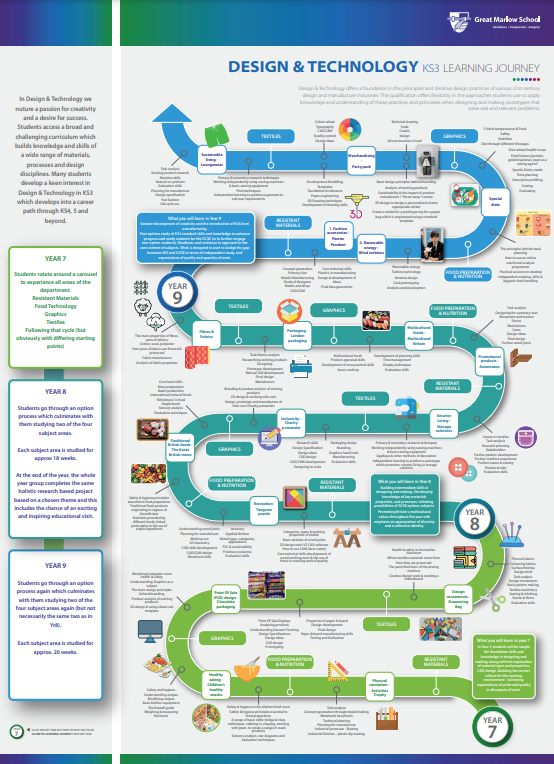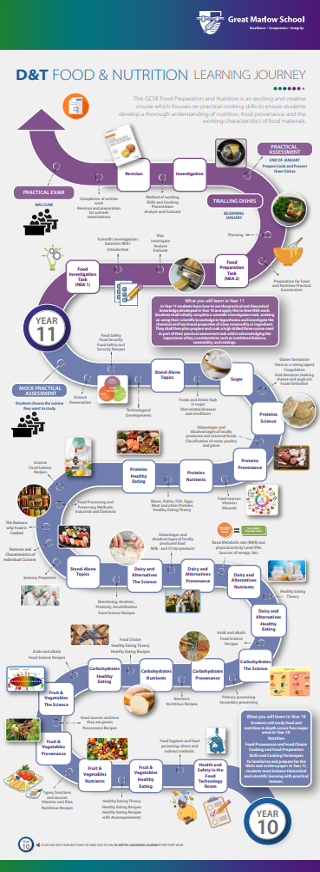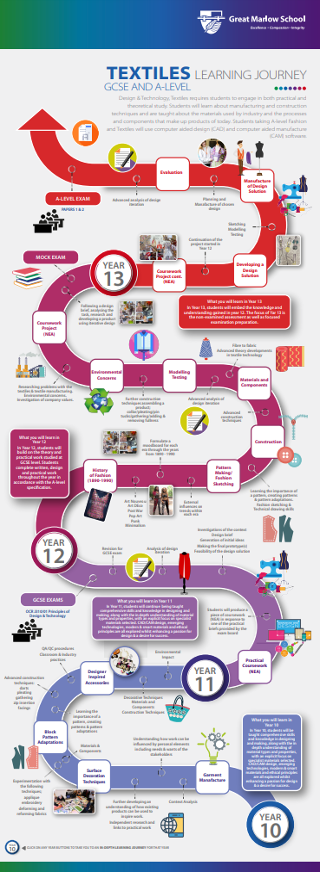
Telephone - 01628 483 752
Company Registration No.07690054
- Welcome
- News & Events
- About Us
- School Life
- Canteen & Catering
- Careers Programme
- Duke of Edinburgh’s Awards
- House System
- Library
- Lockers & Bicycle Racks
- One to One Laptop Scheme
- Parents’ Evenings
- Prefects: Sixth Form & Year 11
- Safeguarding
- School Nurse
- School Transport
- Student Support and SEN
- Teacher Training
- Transition to Year 7
- Uniform, Hair, Jewellery, Phones
- 6th Form
- Curriculum
- Parent & Carers
- Attendance Guide
- Bucks Family Information Service
- Bucks School Transport
- Communication & Catering
- Friends of Great Marlow School
- Information Evenings
- Gift Aid
- Letters Home
- Mental Health Support
- Online Safety Resources
- Parent/Carer Services
- Progress Review Guides
- School Uniform Shops
- Special Educational Needs
- The Voice – School Newsletter
- Student Area
- Sport
- Gallery
Design & Technology
 ABOUT DESIGN & TECHNOLOGY
ABOUT DESIGN & TECHNOLOGY
“Design and technology is an inspiring, rigorous and practical subject. Using creativity and imagination, [students] design and make products that solve real and relevant problems within a variety of contexts, considering their own and others’ needs, wants and values. They acquire a broad range of subject knowledge and draw on disciplines such as mathematics, science, engineering, computing and art. [Students] learn how to take risks, become resourceful, innovative, enterprising and capable citizens. Through the evaluation of past and present design and technology, they develop a critical understanding of its impact on daily life and the wider world. High-quality design and technology education makes an essential contribution to the creativity, culture, wealth and well-being of the nation.”
From Department for Education: Statutory Guidance 2013
- Design Technology at Great Marlow School
- KS3 Learning Ladders – D&T
- Wider Curriculum – Graphics
- Wider Curriculum – Resistant Materials
- Wider Curriculum – Fashion & Textiles
- Wider Curriculum – Food & Nutrition
- KS3 Resistant Materials and Graphics
- KS3 Textiles
- KS3 Food & Nutrition
- KS4 Textiles
- KS4 Resistant Materials
- KS4 Graphic Products
- KS4 Textiles – Overview
- KS4 Food & Nutrition
- KS4 Learning Ladders – Food & Nutrition
- KS4 Food – Hospitality & Catering
- KS5 Fashion & Textiles
- KS4 & KS5 Learning Ladders – Textiles
DESIGN & TECHNOLOGY AT GREAT MARLOW SCHOOL
All students have to study design and technology until the end of KS3 in line with National Curriculum guidelines. They are timetabled to have two lessons a fortnight, three hours in total: one double lesson and one single lesson.
In Year 7 we operate a carousel system which allows the students to move around the different subject areas of Design and Technology and experience how the subject works. This differs from previous experience in KS1 and KS2. Students experience a number of weeks in each of the three areas of study: resistant materials, graphics and textiles. Students also study food nutrition.
Students are given the opportunity to design and make products. They are challenged to solve problems for themselves: to think critically as they would have to for clients or target markets in the wider world. The curriculum offers the chance to work with different materials and equipment and this widens their knowledge and experience, thus broadening their outlook.
Students complete two assessment tasks in each part of the carousel and are given assessment grades that track their progress.
In Year 8 students opt for two of the Design and Technology disciplines allowing them to focus more time and energy on developing skills and knowledge in areas that they feel they can make greater progress, and which they have greater enjoyment. Longer courses are provided to enable students the time and opportunity to gain greater depth of knowledge and skill which is retained for Year 9.
In Year 9 students are again provided with a timely experience of two D&T subject areas, ahead of selecting options for GCSE. Higher-level processes, skills, and standards are expected as we build towards GCSE level quality of work. Following the GCSE options process all students partake in a short fast-paced design challenge, which is given across the year group to explore a given context.
At GCSE level, Design and Technology includes studying one of the following specialisms: resistant materials, graphics or textiles. Food Nutrition sits outside D&T GCSE, therefore, it features in a separate option block. Candidates can opt for Food Nutrition as well as one of the design and technology subjects.
All subjects require students to show a design process based on specialist knowledge learnt in lessons. Greater knowledge and understanding of the subject is central to achieving a good grade at GCSE.
WIDER CURRICULUM
The Wider Curriculum allows students to take a further interest in their subjects and subject related material they study at school. The Wider Curriculum also enables parents and carers to actively engage with the opportunities offered by each department. Each PDF is hyperlinked, so when you click on them, the links will take you to areas where you may read, view, listen, visit and be creative.
| D&T GRAPHICS WIDER CURRICULUM KS3 |
D&T GRAPHICS WIDER CURRICULUM KS4 |
D&T GRAPHICS WIDER CURRICULUM KS5 |
||
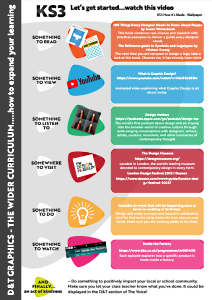 |
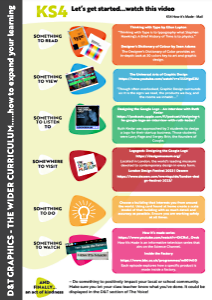 |
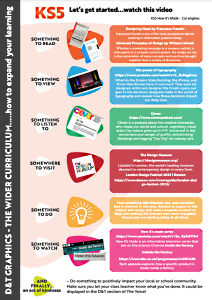 |
WIDER CURRICULUM
The Wider Curriculum allows students to take a further interest in their subjects and subject related material they study at school. The Wider Curriculum also enables parents and carers to actively engage with the opportunities offered by each department. Each PDF is hyperlinked, so when you click on them, the links will take you to areas where you may read, view, listen, visit and be creative.
| RESISTANT MATERIALS WIDER CURRICULUM KS3 |
RESISTANT MATERIALS WIDER CURRICULUM KS4 |
RESISTANT MATERIALS WIDER CURRICULUM KS5 |
||
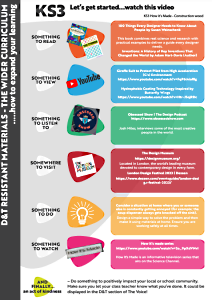 |
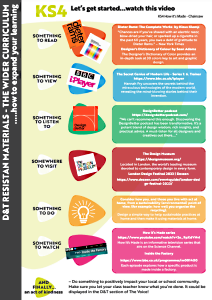 |
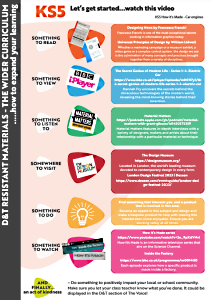 |
WIDER CURRICULUM
The Wider Curriculum allows students to take a further interest in their subjects and subject related material they study at school. The Wider Curriculum also enables parents and carers to actively engage with the opportunities offered by each department. Each PDF is hyperlinked, so when you click on them, the links will take you to areas where you may read, view, listen, visit and be creative.
| D&T FASHION & TEXTILES WIDER CURRICULUM KS3 |
D&T FASHION & TEXTILES WIDER CURRICULUM KS4 |
D&T FASHION & TEXTILES WIDER CURRICULUM KS5 |
||
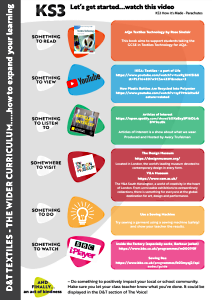 |
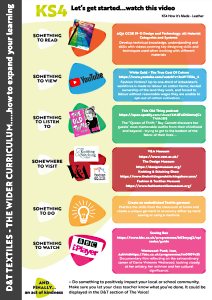 |
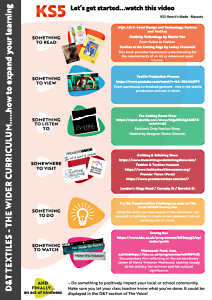 |
WIDER CURRICULUM
The Wider Curriculum allows students to take a further interest in their subjects and subject related material they study at school. The Wider Curriculum also enables parents and carers to actively engage with the opportunities offered by each department. Each PDF is hyperlinked, so when you click on them, the links will take you to areas where you may read, view, listen, visit and be creative.
| D&T FOOD & NUTRITION WIDER CURRICULUM KS3 |
D&T FOOD & NUTRITION WIDER CURRICULUM KS4 |
|
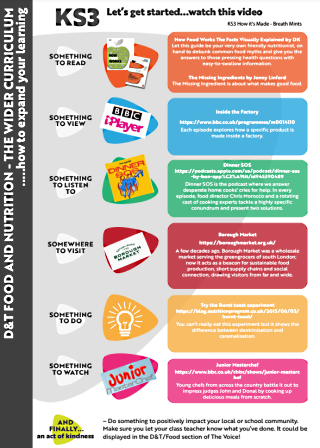 |
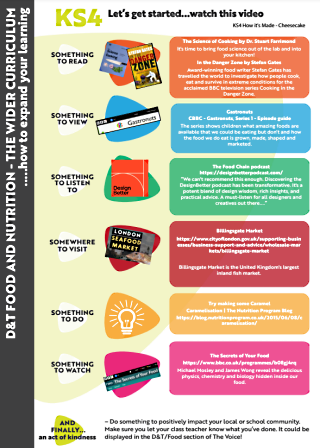 |
KEY STAGE 3 – RESISTANT MATERIALS & GRAPHICS
Year 7 Resistant Materials
Activities Trophy
Students work through a simplified design process in order to appreciate the importance of design within technology. Alongside designing, students gain a foundation understanding of the workings of a school workshop whilst building the skills involved in cutting, shaping, joining, and finishing metals. A small experience of woodwork is also included.
Key learning: design process (analysis, research, concept design through model making, dimensioning final designs, planning for manufacture, manufacture, evaluation)
Key processes: metalworking hand tools, brazing, plastic dip coating (+pillar drill and band facer for wood)
Year 7 Graphic Products
Chocolate Bar Packaging
Students use their creativity to design, brand and make packaging for their own design of chocolate bars. This encompasses the design process and focuses on foundation computer-aided design (CAD) skills and computer aided manufacture (CAM) work, using processes such as vacuum forming and the laser cutting.
Key learning: design process (analysis, research, concept design through model making, designing to key restraints, manufacture, evaluation).
Key processes: CAD/CAD in design and technology, laser cutting, vacuum forming.
Year 8 Resistant Materials
Tangram Puzzle with Display Box
Students begin to learn more about working with different materials, tools, and machines as they develop their practical skills, particularly in woodwork. Being able to use tools and machines is an essential skill as students move towards working with plastics before designing and making a tangram puzzle and display box.
Key learning: wood joints, development of practical skills, appreciation of extended machinery for different materials, extended CAD design, layout design.
Key Processes: woodworking hand tools, band facer, gluing timber, basic plastics tools, CAD/CAM designing, laser cutter.
Automation Book Promoter
Students build on their prior knowledge and develop skills in designing to a brief. Adding learning of forces, movement and motion to greater depth of wood joints and techniques
enables students to realise their designs of a moveable promotional display for a children’s book.
Key learning: further wood joints, broader development of practical skills in wood, layout design.
Key Processes: woodworking hand tools, band facer, gluing timber.
Year 8 Graphics
The Gift Box
In this unit, students build on skills developed throughout the D&T technology course, as they work to solve the problem of how to create gift packaging that can compete with an already saturated market. The challenge involves students researching and developing scenarios, in doing so they learn about packaging and the use of nets in graphic design. Final designs are presented as card prototypes.
Key learning: working with card, development of packaging nets, further CAD design skills, drawing to scale, development of accuracy within practical elements.
Key Processes: card/paper practical working tools, CAD/CAM designing, the design process.
Charity Air Freshener
Students are challenged to find a charity that they could represent a promotional air freshener design to. Building around ‘blister pack’ packaging the students discover how to design when considering ‘different’ materials and shapes, and how to use creativity to realise designs that are contemporary and innovative, yet relating to a chosen theme. Final designs are presented as workable products.
Key learning: working with card, further development of nets, enhanced CAD design skills, drawing to scale, development of accuracy within practical elements.
Key Processes: card/paper practical working tools, CAD/CAM designing, the design process, vacuum forming.
Year 8 Design in Context
Classic British Design
All students in Year 8 finish the course with a project to explore and present research information on a selection of ‘Classic British Designs’ from modern history. To inform and educate the year group they are taken to London to visit the fantastic galleries and workshops of the Design Museum. In the afternoon, they are given a tour of the London sights to witness how design has influenced the key features of the city. Students study freedom of conceptual design coupled with key elements of the design process (research, presentation).
Key learning: appreciation of the important influence of British designers within the UK and around the world, (creativity, materials, user-led solutions) teamwork and responsibility, research and presentation skills.
Year 9 Resistant Materials
Pewter Pendant
Students explore the possibilities of working with mixed materials (in this case metals and plastics). They design and make pendants, including jewellery and key rings, which manifest themselves as cast pewter products with acrylic inlays.
Key learning: Design process (analysis, concept design final designs, planning for manufacture, manufacture); working with metals; working with plastics, CAD/CAM, the rewards of resilience and quality in manufacturing.
Key processes: plastics hand tools, metalwork hand tools, pillar drill, buffing wheel, CAD/CAM, laser cutter, low temperature pewter casting.
Pewter Pendant Display Stand
Students expand on their knowledge of the properties of materials by focussing on plastics and different ways of thermoforming. Continuing the theme from their previous project (pewter pendant) students have the freedom to fully challenge their creativity with a design that is purely conceptual before developing their practical skills with a structured thermoforming task.
Key learning: Design process (analysis, concept design final designs, planning for manufacture, manufacture); working with plastics, quality in manufacturing.
Key processes: plastics hand tools, pillar drill, buffing wheel, line bender.
Year 9 Graphics
Desktop Storage Solution
Students focus on designing for mono-part manufacture, looking at using nets within the designing and manufacturing of acrylic desktop storage units. ‘Designing to fit’ is a key discipline to develop in this project which combines higher level planning and development with modern manufacturing CAD/CAM.
Key learning: full design process (analysis, research, concept design through testing, dimensional final designs, planning for manufacture, manufacture, evaluation).
Key Processes: prototyping, CAD/CAM, laser cutter, line bender, plastics hand tools
Party Bag Students focus on branding and how this can be successful across mediums/materials within the design of products. The design process is utilised and followed, to produce designs for the branding of a party bag itself, as well as its contents. CAD/CAM and solid modelling are prominent skills developed in this project. Key learning: full design process (analysis, research, concept design through testing, solid modelling, dimensional final designs, planning for manufacture, manufacture, evaluation). Key Processes: prototyping, CAD/CAM (CAMM1 vinyl cutter), card/board hand tools.
Year 9 Design in Context
Holistic Design Project – group work Following the GCSE options process, classes are reorganised so that students who have opted for a specialism are placed in that subject area. The whole year group is set the same context, which must be solved from the point of view of the subject area that they are in. The ethos behind this is that students can develop their teamwork skills whilst fine tuning the foundation knowledge and skills from KS3 so that they are best prepared for the requirements of KS4. Key learning: appreciation of the links across all subject areas of Design and Technology. Following the standard design process to further unlock creativity, to refine and enhance skills, and to consolidate and build on knowledge.
KEY STAGE 3 D&T – TEXTILES
Year 7 Textiles
Aesthetics through Design Movement – Drawstring Bag
Students work through a simplified design process, in order to appreciate the importance of design within technology. Alongside designing and making, students gain an understanding of the workings of the equipment used in textiles.
The design challenge has been introduced to give students the opportunity to explore a variety of ‘Design Movements’ before they opt for a design for their own product.
Key learning: students learn a variety of surface decoration methods combined with learning how to use a sewing machine to create an aesthetically pleasing product
Year 8 Design in Context
Classic British Design
All students in Year 8 begin the course with a project to explore and present research information on a selection of ‘Classic British Designs’ from modern history. To inform and educate the year group, they are taken to London to visit the fantastic galleries and workshops of the Design Museum. In the afternoon, they are given a tour of the London sights to witness how design has influenced the key features of the city. Students study freedom of conceptual design coupled with key elements of the design process (research and presentation).
Key learning: appreciation of the important influence of British designers within the UK and around the world, (including creativity, materials and user-led solutions). Teamwork and responsibility, research and presentation skills are key features of this unit.
Year 8 Textiles
Project 1: Smarter Living- Bedroom Organiser
Students who have selected textiles in Year 8 use ‘All Things British’ as their theme to research a variety of bedroom organisers. Contextual design decisions lead the students to create a personalised bedroom organiser for a specific purpose and user: it has to be a product suitable for sale in a tourist retailer outlet.
Students build on their skills from Year 7, learning new methods of fabric decoration techniques (applique) as well as how to apply pockets to fabric. Learning regarding the origins of Textiles is consolidated and properties for specific end uses considered.
Key learning: inserting pockets, applying more complex decorative techniques that focuses on the theme of ‘All things London- through the eyes of a tourist’, development of practical skills, appreciation of extended machinery for different materials and extended CAD design.
Key Processes: the use of 2D-design for CAD designing, printing techniques to include CAM techniques, computerised embroidery, heat pressing, machine skills.
Project 2: Fibre to Fabric
Students are introduced to:
- the sources of fibres – classification and its properties
- using scientific experiments to identify fibre/fabric sources – the burning test
- the main types of fabric construction techniques to include the production of yarns
- understanding the textile labels in their clothing
Year 9 Textiles
Sustainable Living – Working from Home (loungewear)
Students begin to learn more about designing with sustainability as a focus. Students explore and analyse the ways designers currently include sustainability in their designs and consider the environmental impact of textiles at every stage (raw materials, fabric production, product manufacture, distribution and in use). This learning is then contextualised into the contemporary theme of working from home. Students manufacture loungewear trousers to suit a primary user who works from home for all, or part, of the week. Printing techniques are utilised to apply a motif (based on another culture) around the trim of the trousers. Garment manufacturing techniques are introduced, including lay plans, pattern cutting, fusing and joining fabrics: seams, hems and buttonholes are part of the loungewear focus.
The Sustainable Living Challenge incorporates all the key strands: explore, design, model, plan, manufacture and evaluate. Exploring the context for sustainability means the product will be designed and made for a wider stakeholder.
Key learning: understanding product branding, designing a logo to meet the demands of the context, understanding pattern development and lay planning, development of practical skills through modelling, appreciation of extended machinery for different materials and extended CAD/CAM skills.
Key Processes: printing techniques to include CAM techniques, computerised embroidery, heat pressing, applique techniques, machine skills
KEY STAGE 3 – FOOD PREPARATION & NUTRITION
Healthy Snacks – Children’s Healthy Snacks
Students are introduced to a wide range of basic food hygiene and safety knowledge, they are taught to understand nutrition: the importance of fruit and vegetables and finding their way around the school kitchen through learning about basic food skills. Students are also introduced to the UK Eatwell Guide.
Key learning: making healthy food choices, understanding fruit, core food skills- analysis, research, cooking skills and evaluation.
Key processes: basic knife skills (claw and bridge), rubbing-in method, creaming method, kneading, shapening, melting and pastry skills (shortcrust). Students learn how to use the oven for baking.
Year 8 Design in Context
Classic British Design
All students in Year 8 begin the course with a project to explore and present research information on a selection of ‘Classic British Designs’ from modern history. To inform and educate the year group they are taken to London to visit the fantastic galleries and workshops of the Design Museum. In the afternoon, they are given a tour of the London sights to witness how design has influenced the key features of the city. Students study freedom of conceptual design coupled with key elements of the design process (research, presentation).
Key learning: appreciation of the important influence of British designers within the UK and around the world, (creativity, materials, user-led solutions) teamwork and responsibility, research and presentation skills.
Year 8 Food Preparation and Nutrition
Project 1- Great British Menu
This is a very short start as part of the Design and Technology ‘Classic British Design’ project, students explore traditional British cuisines. This gives them the opportunity to analyse food products, then trail some of the popular recipes. Following this student then work in groups to cook a ‘forgotten’ British food, mimicking the tv show- ‘Great British Menu’, which they all sit down and test through a sensory analysis (taste testing).
Project 2- Multicultural Britain- British Multicultural Dishes
Our students are introduced to a wider range of cooking skills, analysing food products through more complex nutritional analysis task, recapping their learning on the UK Eatwell Guide, understanding staples foods and its functions in our body/diet, functions of nutrients, then finally planning and cooking a healthy balanced meal for themselves/family.
Key learning: Making healthy multicultural food choices, understanding functions of food nutrients, core food skills- analysis, research, planning using recipes, more complex cooking skills and evaluation).
Key processes: recap knife skills (claw and bridge), using bought component (filo pastry), sauces, pies, complex food preparation and cooking skills. Students use both the oven and the hob for their meals.
Year 9 Food Preparation and Nutrition
Meals on Budget- Healthy family meals on a limited budget
Our students are introduced to making affordable food choices through planning, preparing, cooking and serving suitable products for different mealtimes (breakfast, mains and desserts and lunch ). More complex skills are trialled independently to meet a chosen dietary need. Sensory analysis are carried out further to understand the complex nutritional needs of their market/family. Finally, they must plan, prepare, cook and serve a 2-course meal on a budget for a family.
Key learning: students are trusted and given choices of recipes to choose from; within the context, Food nutrients and their functions in the body, analyse the Eatwell Guide and plan to meet the demands fully for a dietary need, food analysis, understanding more complex ingredients and cooking skills and evaluations.
Key processes: more complex food preparation, cooking and serving skills. Students use the cooker fully for more complex cooking methods and use other small food preparation equipment/gadgets.
KEY STAGE 4 – DESIGN & TECHNOLOGY – TEXTILES OCR J310 Overview
The textile room is equipped with modern tools and machinery including computerised embroidery machines and printing machines.
GCSE Textiles – Course Content
Year 10 students produce a portfolio of work, which showcases their practical skills. Students build up confidence and assurance through engaging with a number of mini-projects. The projects require students to build on their construction / making skills or engage in a design challenge from a given context. All the activities are aimed at creating an awareness of the demands of the non-examination assessment tasks (NEA), which carries a 50% weighting at GCSE.
The projects are an important way for students to develop an understanding of basic and complex skills, including pattern development and adaptation, as well as complex fabric decoration techniques involving CAD / CAM skills: a more complex and independent use of machinery in textiles is promoted.
The project culminates in a fashion show at the end of the spring term, where students exhibit their clothes and accessories made during the course.
The theoretical content is taught alongside the practical tasks.
The skills taught in Textiles GCSE include: understanding fibres and fabrics to help inform material choices for products; the different techniques employed for joining and neatening fabrics; how to manipulate material into ruffles and pleats; understanding the importance of colour and texture. In addition, the embellishment of textiles with a wide range of equipment and materials to include CAD/CAM processes and Smart materials.
The first half of Year 11 is focused on the GCSE NEA task, which is set by the exam board and sent to the school in the spring term of Year 10. Students are required to choose one out of the given context/topics set by OCR; they are tasked with demonstrating their understanding of, and skills in, iterative design and making challenges.
Assessment:
The non-examined assessment task (NEA) is worth 50% of the final grade. It is teacher assessed and externally moderated.
The 2-hour written examination is worth 50%: it tests the ‘Principles of Design and Technology’
GCSE grades are numbered 9 to 1: the top grade being 9.
KEY STAGE 4 – DESIGN TECHNOLOGY – RESISTANT MATERIALS
Year 10
During Year 10, students develop a high level of accuracy and precision in marking out and cutting materials with hand and machine tools. Students are offered opportunities to work with a combination of wood, metal or plastic.
Year 11
During Year 11, students will be expected to apply the skills and knowledge learnt in Year 10 to a high level, solving real problems for their major non-exam assessment (NEA). The work will culminate in a portfolio presenting their quality product, charting their initial ideas, the proposed methods of manufacture and details of construction. In the past, students have worked on finding solutions for storage, lighting, furniture, young children’s education, and charity representation.
Course content
Students undertake an extended design and make a project that encompasses the basic principles required for the qualification. The two-year GCSE includes learning about: core technical principles; specialist technical principles; and designing and making principles.
The NEA Iterative Design Challenge requires students to produce a variety of prototypes and a portfolio of evidence. The work will be internally assessed and externally moderated.
Assessment
The Resistant Materials non-exam assessment (NEA) is worth 50% of the final grade and will be approximately 40 hours of work.
A 2-hour written exam worth is 50% of the final GCSE grade. The examination tests understanding of the key principles of design and technology.
GCSE grades are numbered 9 to 1: the top grade being 9.
KEY STAGE 4 – DESIGN TECHNOLOGY – GRAPHIC PRODUCTS
Students studying GCSE Graphic Products will enjoy developing their practical skills in a way similar to those who develop products in industry, by using modern and traditional materials in an imaginative way. The course introduces students to commercial design; the standard graphics materials used by industry; how products and packages are made; and the importance of being precise and accurate. Students also learn about career opportunities in the design and creative industries.
Course content
Students undertake to produce an ‘extended design and make’ project, which encompasses all the basic principles learnt over the two-year course: core technical principles; specialist technical principles; designing and making principles.
The NEA Iterative Design Challenge requires students to produce a variety of prototypes and display a portfolio of evidence. In previous years candidates have found solutions for packaging, fragrance containers, confectionery and ‘pop-up’ technology.
The work submitted for examination is internally assessed and externally moderated.
Assessment
The Graphic Design non-exam assessment (NEA) is worth 50% of the final grade and will be approximately 40 hours of work.
A 2 hour written exam worth is 50% of the final GCSE grade. The examination tests understanding of the key principles of design and technology.
GCSE grades are numbered 9 to 1: the top grade being 9.
KEY STAGE 4 – DESIGN TECHNOLOGY – TEXTILES OCR J310
The textile room is equipped with modern equipment and technology including computerised embroidery machines and printing machines.
Course content
Year 10 students work towards having a portfolio of work showcasing their practical work. A number of skills are developed through three mini projects that requires them to either build on their construction/making skills or a design and make challenge from a given context. The activities are designed to allow students to understand the demands of the Non-Examined Assessment Tasks (NEA), which has replaced the former controlled assessment, but still carries a 50% weighting. The project also develops an understanding of basic and complex skills, including pattern development/adaptation techniques, complex fabric decorating techniques, CAD/CAM skills, and more complex and independent use of the machinery in textiles. The project culminates in a fashion show at the end of the spring term where candidates exhibit the clothes/products they have designed and made. The theoretical content is taught in conjunction with the practical tasks.
The key skills taught in textiles: understanding fibres and fabrics to inform material choices for products, different kinds of seam/hems, the manipulation of material into say ruffles and pleats; the importance of colour and texture. In addition, the embellishment of textiles with a wide range of equipment and materials to include CAD/CAM processes and Smart materials.
The first half of Year 11 is focused on the main GCSE NEA task, which is set by the exam board and sent to the school in the autumn term. Students are required to choose one out of the given context/topics set by OCR to demonstrate their understanding of and skills in iterative design and making challenge.
Assessment:
The Non-Examined Assessment Task (NEA) is worth 50% of the final grade. It is teacher assessed and externally moderated.
The 2-hour written examination is worth 50%: it tests the ‘Principles of Design and Technology’
GCSE grades are numbered 9 to 1: the top grade being 9.
KEY STAGE 4 – FOOD PREPARATION AND NUTRITION – OCR J309
GCSE Food Preparation and Nutrition is an exciting course about food choices and the preparation of products that promote good health. The course is skills based, there is a practical focus on the preparation and cooking of a wide variety of foods; they are closely linked to the choice of ingredients and their purpose: food science, nutrition and food safety.
In food, there are two specialist rooms, both fully fitted with all the necessary equipment for the curriculum.
The Course
Food preparation skills are divided into five sections: Food Nutrition and Health; Food Safety; Food Science; Food Provenance; Food Choice.
In Year 10 students develop a wide range of skills that encourage confidence in practical and theoretical knowledge of food and nutrition. Short term tasks are set targeting the core knowledge and skills required. The key skills and understanding of the science behind the preparation and cooking of foods is taught. Included as a foundation to the course is the understanding of the baking of cakes and pastry; the carbohydrates of pasta, potatoes and rice; the cooking of proteins; the importance of fibre; and the preparation and cooking of sauces that complement dishes.
In the second half of Year 10, students undertake a mini version of the two NEA tasks, in order to give a valuable insight into the demands of the NEA tasks in Year 11. This undertaking gives an understanding of how to select and use more complex cooking and experimenting skills, giving access to the higher-grade bands.
The first half of Year 11 is focused on the main GCSE NEA task, which is set by the examination board in the autumn term. The NEA tasks are split into two parts: the first covers scientific food experiments; the second part focuses on selecting, planning, making and evaluating two products.
Practical sessions take place every fortnight in a double lesson, for these lessons students are required to provide their own ingredients and must be prepared to assume this commitment on both a financial and organisational basis.
However, in Year 11, students can opt to participate in a group ordering scheme: a £40 contribution enables the school to purchase all the required ingredients for both NEA 1 and 2.
Assessment
All assessment tasks are completed in school.
The Non-Exam Assessment Task (NEA) is worth 50% of the final grade. It is teacher assessed and externally moderated.
Task 1: Food Investigation (15%)
Task 2: Food Preparation Assessment (35%)
A three-hour practical examination is part of the assessment.
The 1¾ hour Food Preparation and Nutrition written exam, is worth 50% of final grade.
GCSE grades are numbered 9 to 1: the top grade being 9
KEY STAGE 4 – FOOD
LEVEL 1/2 VOCATIONAL AWARD IN HOSPITALITY and CATERING – WJEC 5569
‘The hospitality and catering sector includes all businesses that provide food, beverages, and/or accommodation services. This includes restaurants, hotels, pubs and bars. It also includes airlines, tourist attractions, hospitals and sports venues; businesses where hospitality and catering is not their primary service but is increasingly important to their success. According to the British Hospitality Association, hospitality and catering is Britain’s fourth largest industry and accounts for around 10% of the total workforce. Since 2010, over 25% of all new jobs have been within the hospitality and catering sector with the majority of new roles falling within the 18-24 age group, according to a report by People 1st’.
The Eduqas (WJEC) Level 1/2 Vocational Award in Hospitality and Catering is most suitable as a foundation for further study, providing learners with a core depth of knowledge and a range of specialist and general skills that will support their progression to further learning and employment.
The three key features are:
- Knowledge and understanding of the hospitality and catering industry
- Develops ability to plan, prepare and cook dishes
- Develops practical skills for the catering industry.
Level 1/2 Vocational Award in Hospitality and Catering course is skills based, there is a practical focus on the preparation and cooking of a wide variety of foods; they are closely linked to the choice of ingredients and their purpose: nutrition and food safety/hygiene in the hospitality industry. This structure has been designed to develop in learners, the knowledge and understanding related to a range of hospitality and catering providers; how they operate and what they have to consider to be successful. There is the opportunity to learn about issues related to nutrition and food safety and how they affect successful hospitality and catering operations. In this qualification, learners will also have the opportunity to develop some food preparation and cooking skills as well as transferable skills of problem solving, organisation and time management, planning and communication. Through the two units, learners will gain an overview of the hospitality and catering industry and the type of job roles that may be available to assist them in making choices about progression.
In food, there are two specialist rooms, both fully fitted with all the necessary equipment for the curriculum.
Course Content
In Year 10 students develop a wide range of skills that encourage confidence in practical and theoretical knowledge of the hospitality and catering industry. More complex food preparation, cooking and serving skills are taught though teacher demonstration and students involvement. As part of the course our students are giving opportunities to visit the hospitality and catering industries in the local area for observations and workshops to build on their learning in the classroom.
In the second term of Year 10, students undertake a mini version of the NEA task, in order to give a valuable insight into the demands of the NEA tasks in Year 11. This undertaking gives an understanding of how to select and use more complex planning, preparing and cooking and skills, giving access to the higher-grade bands.
The first half of Year 11 is focused on the main GCSE NEA task, which is set by the examination board in the autumn term. As compared to the NEA tasks for students taking the Food Preparation and Nutrition route- this is more focused on the practical skills with some written planning, analysis and evaluations to support a series of practical tasks.
Practical sessions take place every week in the double lesson, for these lessons students are required to provide their own ingredients and must be prepared to assume this commitment on both a financial and organisational basis.
However, in Year 11 students can opt to participate in a group ordering scheme:£40 contribution enables the school to purchase all the required ingredients for extensive cooking their NEA task.
Assessment
The Eduqas/WJEC Level 1/2 Vocational Award in Hospitality and Catering is made up of two mandatory units:
- Unit 1 The Hospitality and Catering Industry
- Unit 2 Hospitality and Catering in Action Learners must complete both units.
All assessment tasks are completed in school.
-
- Hospitality and Catering in Action
- The Non-Exam Assessment Task (NEA) is worth 60% of the final grade. It is teacher assessed and externally moderated. There are five tasks that are set by the exam board to be taken for this practical assessment task.
- There are three stages of assessment that will be controlled:
- Task setting
- Task taking
- Task marking
- There are three stages of assessment that will be controlled:
- The Non-Exam Assessment Task (NEA) is worth 60% of the final grade. It is teacher assessed and externally moderated. There are five tasks that are set by the exam board to be taken for this practical assessment task.
- Hospitality and Catering in Action
-
- The Hospitality and Catering Industry – Paper based assessment
- The 1 ½ hour written exam, is worth 50% of final grade.- This is written in year 10 with a possibility of a resit in year 11.
- The Hospitality and Catering Industry – Paper based assessment
Level 1 Pass, Level 2 Pass, Level 2 Merit, Level 2 Distinction*. These are equivalent to the new GCSE grades are numbered 9 to 1: the top grade being 9
KEY STAGE 5 – DESIGN AND TECHNOLOGY – FASHION AND TEXTILES AQA 7562
GCE Design and Technology- Fashion and Textiles prepares students to be confident and successful in this technological world and for the ever-changing job market. They learn how historical, social, cultural, environmental and economic factors have influenced design and technology over time. University courses are, more and more, preferring students with design backgrounds and this department is excited about preparing the next generation to be innovative designers and manufacturers.
The course requires students to design and make a quality product as part of their assessment in Year 2. Students are taught about the materials used by industry and the processes and components that make up the products of today. Students also study issues of health and safety; systems controlling the quality of design and manufacture; and industrial methods and applications. All the design and technology options use a range of ICT skills in the non-examination assessment NEA projects. Students taking A-level Fashion and Textiles will use computer aided design (CAD) and computer aided manufacture (CAM) software.
In Year 12 students will develop knowledge and understanding of the core skills required for this specialism. Mini projects and theory lessons prepare students for their A-Level examination. In Year 13 the extended project forms an important component of the final examination grade., constituting to 50% of their final grade.
Course guides, template sheets and exemplar work are provided to assist students with their folder work. Revision guides and additional sessions after school on a weekly basis enable students to reach their potential and achieve their target grade at GCE. All students will be expected to follow an exemplary code of conduct in potentially hazardous work environments.
The courses are timetabled for the following hours: in KS5 there are 8 timetabled hours. Students are also expected to complete independent study sessions in the department.
Course content
This is a two-year A-level course that needs to be studied for both years in order to attain an A-level grade in Fashion and Textiles.
Year 12 students work towards having a portfolio of work showcasing both their theoretical knowledge and practical skills. These are taught through a series of mini challenges:
- Design practice
- Textile processes
- Garment making processes
A number of skills are developed through these mini projects that require them to either build on their design and making skills or theoretical skills. The activities are designed to allow students to understand the demands of the non-examined assessment tasks (NEA). This NEA has replaced the former coursework tasks at A2, but still carries a 50% weighting.
The key skills taught at A-level are the following:
- to design to meet the needs of either a context that solves a problem in society
- to design to bring a new/unique idea onto the market or identify a niche in
- to design to for a market that has been informed by the stakeholders.
Assessment:
The non-examined assessment task (NEA) is worth 100 marks and is 50% of the final grade. of the final grade.
This substantial design and make project involves the practical application of core technical principles; core designing and making principles; and additional specialised knowledge. It is teacher assessed and externally moderated.
There are two written examinations worth 50%:
- Paper 1- Technical Principles: 2 hours 30 minutes – 120 marks – worth 30%. A mixture of short answer r and extended response questions.
- Paper 2 Designing and Making Principles: 1 hour 30 minutes – 80 marks worth 20%. A mixture of short answers and extended response questions.
A -level grades are A* to E: the top-grade being A*.
